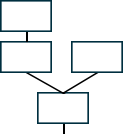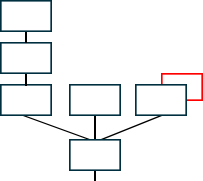
 |
quick manual | algorithms | dx max(4): options, pictures, destroy and repair
Algorithm building blocks
The 32 algorithms are constructed using a combination of only 12
different basic building blocks (when you omit counting the different
feedback operators). Only 1 (predefined) operator in an algorithm can
support a feedback loop. The building blocks consist of 1 to 6
operators in different configurations.
The DX7 implements the following:
- 1 operator: 1 unique building block
- 2 operators: 1 unique building block
- 3 operators: 3 unique building blocks
- 4 operators: 5 unique building blocks
- 5 operators: there are no building blocks consisting of 5 operators
- 6 operators: 2 unique building blocks
Below are the different building blocks (including the feedback
possibilities) for every number of operators:
| 1 | a | b | c |
| 1 |  |
||
| 2 | a | b | c |
| 2 |  |
 |
 |
| 3 | a | b | c |
| 3.1 |  |
 |
 |
| 3.2 |  |
 |
|
| 3.3 |  |
 |
|
| 4 | a | b | c |
| 4.1 |  |
 |
GEMIST |
| 4.2 |  |
 |
|
| 4.3 |  |
 |
|
| 4.4 |  |
 |
|
| 4.5 |  |
 |
 |
| 6 | a | b | c |
| 6.1 |  |
||
| 6.2 |  |
 |
The 32 algorithms consist of the following building blocks:
| # | 1 | 2 | 3 | 4 | 5 | 6 | |
| 1 | 2-a | 4.1-b | |||||
| 2 | 2-b | 4.1-a | |||||
| 3 | 3.1-a 3.1-b |
||||||
| 4 | 4.1-a 4.1-c |
||||||
| 5 | 2-a 2-a 2-b |
||||||
| 6 | 2-a 2-a 2-c |
||||||
| 7 | 2-a | 4.5-b | |||||
| 8 | 2-a | 4.5-c | |||||
| 9 | |||||||
| 10 | |||||||
| 11 | |||||||
| 12 | |||||||
| 13 | |||||||
| 14 | |||||||
| 15 | |||||||
| 16 | |||||||
| 17 | |||||||
| 18 | |||||||
| 19 | |||||||
| 20 | |||||||
| 21 | |||||||
| 22 | |||||||
| 23 | |||||||
| 24 | |||||||
| 25 | |||||||
| 26 | |||||||
| 27 | |||||||
| 28 | |||||||
| 29 | |||||||
| 30 | |||||||
| 31 | |||||||
| 32 |